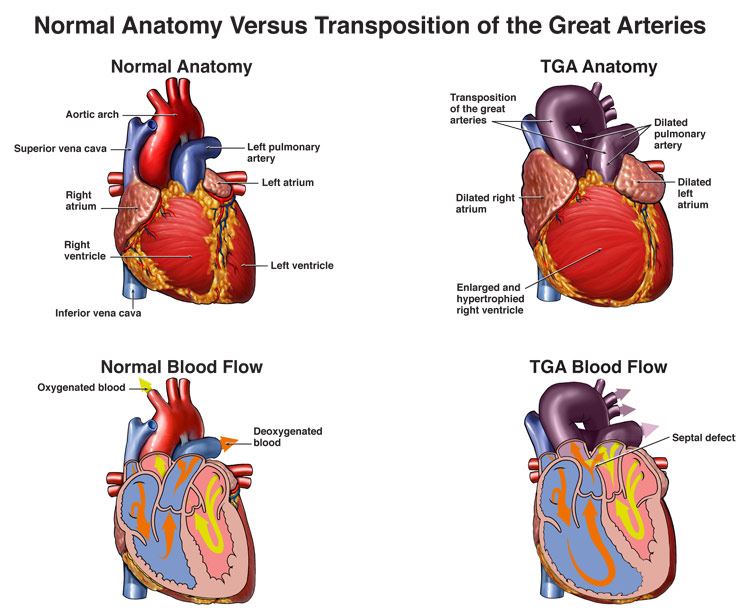D-Transposition of the Great Arteries
D-Transposition of the great arteries, or TGA, is a congenital birth defect (present at birth) in which the two main arteries carrying blood out of the heart, the main pulmonary artery and the aorta, are switched in position, or “transposed.” There are two types: dextro TGA (d-TGA) and levo TGA (l-TGA).
In a baby without a congenital heart defect, the right side of the heart pumps oxygen-poor blood from the heart to the lungs through the pulmonary artery. The left side of the heart pumps oxygen-rich blood to the rest of the body through the aorta. The aorta is usually behind the pulmonary artery.
In d-TGA, the aorta is in front of the pulmonary artery and to the right (dextro) of the pulmonary artery. This means oxygen-poor blood from the body enters the right side of the heart. But, instead of going to the lungs, the blood is pumped directly back out to the rest of the body through the aorta. Oxygen-rich blood from the lungs entering the heart is pumped straight back to the lungs through the main pulmonary artery.
In order for your child to survive, this condition requires surgery at or shortly after birth. After successful surgery, your doctor will continue to monitor your condition throughout your life.

Medical Illustration Copyright © 2019 Nucleus Medical Media, All rights reserved.
Causes of D-Transposition of the Great Arteries
Doctors know that heart defects present at birth (congenital) arise from errors early in the heart's development, but there's often no clear cause.
Symptoms of D-Transposition of the Great Arteries
After initial surgery, some people with this condition may not experience symptoms for many years. Once symptoms begin to appear, these can include:
- Fatigue
- Heart palpitations
- Heart murmur
- Shortness of breath
Diagnosis of D-Transposition of the Great Arteries
To diagnose this condition, your doctor will perform a variety of tests, including:
- Echocardiogram (ECHO)
- Electrocardiogram (EKG/ECG)
- Stress test
- Cardiac catheterization
- Computed tomography (CT scan)
- Magnetic resonance imaging (MRI)
Treatment of D-Transposition of the Great Arteries
Children and adults with this condition will require regular monitoring for any changes in their condition. If the condition worsens, your doctor may recommend a specific procedure. Some treatment options include medications and medical and surgical procedures.
Medications
- Prostaglandin E1 (alprostadil) helps keep the connection between the aorta and pulmonary artery open (ductus arteriosus); this is only possible at birth. This increases the amount of blood flow and improves mixing of oxygen-poor and oxygen-rich blood until surgery can be performed.
